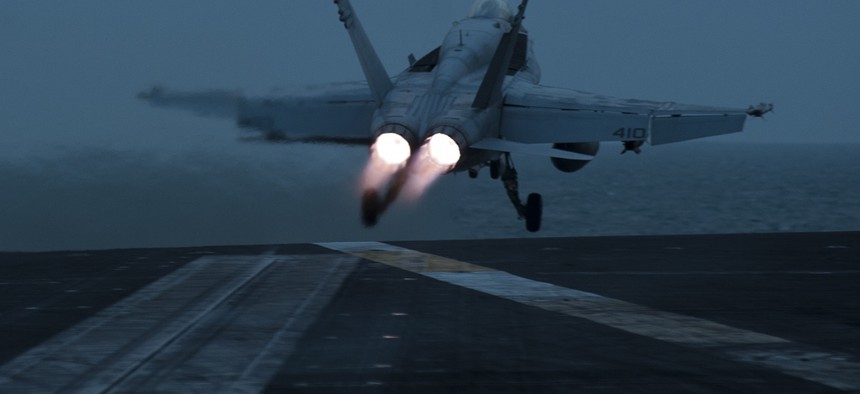
One of the Navy's F/A 18C jets taking off. The Pentagon's upcoming budget will likely not purchase any more of the aircraft U.S. Navy photo by Mass Communication Specialist 3rd Class Benjamin Crossley
What's on the Chopping Block—and What's Safe—in the Pentagon's Shrinking Budget?
Here's a look at what might get cut, and what might make the cut. By Sara Sorcher
On your marks, defense wonks.
This year's scramble in Washington over the budget request will start Monday, when Defense Secretary Chuck Hagel is expected to preview the fiscal 2015 Defense Department budget—a week before the official request goes to Congress.
Its first hint at budget priorities will spur the defense industry to start lobbying, lawmakers to stake out their priorities, and the Pentagon to launch a charm offensive on Capitol Hill. And everyone involved will be chasing the same goal: keeping their priorities safe from cuts, even if that means nudging someone else's pet project.
Before the budget Hunger Games begin, here are a few key priorities that could be on the chopping block as the Pentagon decides how to cut tens of billions of dollars—and what might escape the ax.
1. The Untouchables: What the Pentagon wants to trim, but can't.
Personnel Costs
Neither Congress nor the Pentagon appear willing to propose big reforms to curb the rapid growth of military pay and benefits, until a commission makes recommendations in February 2015. Still, some "fine-tune adjustments" could be coming: Military pay raises capped at 1 percent; housing allowances changed; and fees were instituted for Tricare for Life, the health care program for retirees 65 and older.
Bases
The Pentagon may attempt to lay the groundwork for a round of base closures. But Congress has rebuffed these attempts in the past, and even though the department says it does not need these facilities, many defense officials accept that politically speaking it's still a virtually impossible ask in an election year.
The bottom line
"Congress is basically fencing off over 60 percent of the defense budget, and saying, 'You cannot touch this,' " said Mackenzie Eaglen of the conservative American Enterprise Institute think tank. "When you cordon off so much of the defense budget as untouchable, it's going to make the cuts all the more steep in other accounts.... They're increasingly fighting over a shrinking pot of money called 'procurement.' "
2. The 'Losers': Programs that could be eliminated...
...Or "postponed," potentially, forever. Many have been touted as top priorities to update or replace aging weapons systems or equipment.
The Air Force's A-10
Last year, the Air Force tried to retire the Warthog fleet to free up cash for other, newer aircraft that could take over its close-air support mission—but Congress refused. "I would go to Vegas and put my money on it" being slashed from this budget request, Eaglen said. There's already opposition brewing: Republican Sen. Kelly Ayotte of New Hampshire (whose husband is a former A-10 pilot) is leading the charge on Capitol Hill.
The Marine Corps' Amphibious Combat Vehicle
The ACV was also once a top priority, but the service may need to go with something more modest instead, such as the Marine Personnel Carrier.
The cheaper option could have consequences. Marines need a vehicle that can get from ship to shore while protecting those on board. The service has been trying to develop a successor to its existing—and vintage—AAV-7 amphibious transports. Without one, the service's entire war-fighting approach could change, said Lexington Institute think tank chief Loren Thompson, a defense-industry consultant. "Traditionally, the Marines have sent most of their force ashore through the surf. If they can't acquire an adequately protected vehicle, they may have to send them on V-22s and helicopters."
The Army's Ground Combat Vehicle
The Army has said the GCV was critical—but now it seems the plan for the secure vehicle intended to carry a full nine-person infantry squad is dead. Congress, presumably with the department's signoff, has essentially nixed the program already by drastically cutting funding. "The 2015 budget is going to put the final nail in the coffin," Eaglen said.
The Army will instead buy a cheaper vehicle, likely an upgrade of the Bradley Fighting Vehicle. "A year ago, the Army was saying the Bradley was not adequately protected," Thompson said, "Now it's looking like the Bradley is the future of ground-combat operations."
The Navy's Super Hornet and Growler
Rumor has it no new versions of the F/A-18 E/F Super Hornet strike fighter or the EA-18 Growler will appear in the Navy's budget request.
The Navy was planning to buy the aircraft until the F-35 was ready. But if the Navy does not order more of the aircraft, or proposes upgrades to it, the St. Louis-based Boeing production line—which supports tens of thousands of jobs—will close. If it's absent from the budget request, Boeing may launch a major lobbying campaign to get Congress to force the Navy to buy more of those planes.
"It's up to the Navy to decide what they want, but we're going to continue to talk about their capabilities," Boeing spokesman Dan Beck said of the programs, though he declined to speculate on what might be—or not be—in the budget request. "We also think that by preserving the capability to produce these aircraft, it's important not only for the future of naval aviation but also for the future of the defense industrial base.
What else?
The Army's Advanced Aerial Scout program—an attempt to replace the aging Kiowa armed reconnaissance helicopter—was a top aviation priority a year ago. But the Army's decision to upgrade the Reagan-era Apaches from the National Guard to do the recon job, and not buy any new airframes, will be reflected in the request, Thompson said.
There are also rumors the Air Force is considering scrapping some or all of its fleet of KC-10 refueling tankers—and not funding combat rescue helicopters, used for search-and-rescue missions and to replace the aging and heavily used Pave Hawk helicopters. Dozens of members of Congress are preemptively pushing back.
The bottom line
If history—from the 1990s-era defense-spending downturn—is a lesson, procurement will be the first, and deepest, cut. But moves to scrap modernization programs for lower cost upgrades means, "to put it bluntly, the U.S. is likely to suffer greater casualties in future wars," Thompson said. "If you keep operating old equipment in place of next-generation then your force is going to be less protected."
3. The (Relative) 'Winners': Major programs the military services can delay.
"Winners" meaning programs trimmed less than everything else.
The Joint Strike Fighter
The Defense Department is planning to request eight fewer F-35 fighter jets than previously planned in its budget. Yes, scaling back the purchase means production for the fifth-generation, stealthy, supersonic aircraft keeps going.
Lockheed Martin can make fewer fighters and be OK financially. But budget cuts will rattle smaller companies already making parts and writing software for planes that won't be ready for years—and delays and uncertainty could actually raise costs, National Journal reported last summer.
Stretching out the program or buying fewer aircraft would be a "penny-wise and a pound-foolish" strategy, a senior Lockheed official told NJ then. "They might save some, short term, but it's going to cost the taxpayers more over time." Lockheed declined to comment or speculate on any expected reductions prior to the formal budget release.
Littoral Combat Ship
The Pentagon directed the Navy to cut 20 of the littoral combat ships it was planning to buy, from 52 to 32. The instructions were from acting deputy Defense Secretary Christine Fox—but Robert Work, the think-tank CEO and former Navy official nominated to take the spot, has been a strong supporter of the warship. So we'll see.
Cyber and Missile Defense
A few clear winners: Hagel has already promised that money for cyber capabilities—from security to intelligence gathering and reconnaissance—will get a boost.The Pentagon also wants $4.5 billion in extra missile-defense funding over the next five years.
Aircraft Carrier
A narrow escape: The Navy wanted to cut one of the service's 11 aircraft carriers—but the White House, behind the scenes, intervened to stave off a brewing fight with Congress, where members such as House Armed Services Seapower Subcommittee Chairman Randy Forbes are already warning against reductions. The USS George Washington seems to have staved off early retirement this year, but a carrier may eventually go.
Not happy about this? Don't panic—yet.
The Pentagon is planning to submit a $26 billion list of priorities it could not fit in its budget request—but would appreciate, if Congress had the cash.
Whether the priorities lawmakers are upset to see slashed from the base budget show up in that separate list, though, remains to be seen.
